The Replacement of the Population of Crimea: How Many Colonizers Have Actually Moved to the Peninsula
The Monitoring Group of BlackSeaNews
and the Black Sea Institute of Strategic Studies
presents an updated series of articles
«The Socio-Economic Situation in Occupied Crimea in 2014 – 2020»:
Back in the USSR. The Reverse Restructuring of the Crimean Economy
The "Trophy Economy". Militarization as a Factor of Industrial Growth
The "Trophy Economy". The Development of the Stolen Ukrainian Black Sea Shelf
The Commercial Exploitation of Marine Biological Resources
The Crimean "Trophy Economy". The Sale of Ukrainian Property
Occupied Crimea. Exports and Imports in 2014-2020
The Banking System and Investment in Crimea: What is Really Happening on the Occupied Peninsula
Water in Occupied Crimea: No Catastrophe. Just a 50-Year Step Backwards
The Crimean Budget. Small Business. Salaries and Pensions
* * *
"Migration weapons" and the socio-cultural transformation of a population in the process of colonizing new territories by the Russian Empire and the Soviet Union have a long history. Throughout this history, Russia has accumulated considerable experience and built a strong scientific and historical foundation.
The demographic history of Crimea since the peninsula fell into the sphere of Russia's geopolitical interests in the 18th century has consisted of several periods following the same patterns: they always began with the socio-cultural destruction of Crimea and ended with its transformation according to the standards established by the occupiers.
At all historical stages, the Russian Empire and the USSR made extensive use of "migration weapons" in Crimea. Their goal was always to displace (by stimulating emigration or deportation) the indigenous Crimean Tatar population and populate Crimea with newcomers from Russian regions (or even foreign colonists with the necessary competencies).
That is why after the occupation and the attempt to annex the peninsula in 2014 non-recognized by the civilized world, we expected a new demographic policy of the Russian Federation towards Crimea. Note that in Russian history, the managed migration of the Russian population to newly occupied territories has always been part of the redevelopment of the "trophy" area for new purposes aimed at changing the functional specialization of the territory dramatically.
During the occupation, the authors have been conducting monitoring of the official and other relevant information, bearing in mind that Russian statistics in general and the statistics of the occupation administration of Crimea and Sevastopol in particular are not a tool of analysis but largely a means of disinformation.
An array of information in various areas, which has been accumulated since February 2014, makes it possible to draw rather firm conclusions. Unfortunately, the specifics of the situation where the sources of the information live under conditions of total control by the Russian special services and the "iron curtain" do not allow for the traditional references for security reasons. Therefore, the reader will have to take some of the authors' theses on faith.
* * *
It has already become well known that the main goal of the special operation to seize the Crimean peninsula in February 2014 was to restore the function of the "unsinkable aircraft carrier of the empire" in the middle of the Black Sea.
Therefore, when studying migration, it was natural to divide the demographics of Sevastopol as the main military focus of Crimea and the rest of the Crimean peninsula. But, as stated at the beginning of the book, the latest case of another attempt at Russian colonization of Crimea from the beginning was not only about a giant military base but also about a "new international showcase for Russia", a tourist and innovative one like Olympic Sochi.
The analysis of the demographic trends on the peninsula for almost seven years of the occupation will allow us to understand whether those intentions have been realized and in what way.
The size of the resident population of Crimea
(excluding Sevastopol) in 2014-2019
According to the latest pre-war Ukrainian statistics, as at 1 January 2014, i.e. two months before the occupation, the resident population of the Autonomous Republic of Crimea (excluding Sevastopol) was 1,967,200 people.
One of the first measures the Russian Federation took after the occupation was conducting a census. It was taken on 14 October 2014. According to its results, the population of Crimea excluding Sevastopol was 1,889,400 people.
That is, the comparison of the official Ukrainian statistics and the census conducted by the occupiers shows a decrease in the population of occupied Crimea by 77,800 people over the nine months of 2014. This, in turn, gives an understanding of how many people left Crimea immediately after the occupation.
The authors estimate that up to 80-90% of these people, i.e. 60-70 thousand persons, left for mainland Ukraine for fear of oppression.
This migration flow consisted mainly of active participants in the resistance to the occupation, journalists of independent media, civil activists of pro-Ukrainian organizations, including Crimean Tatar ones, and other people who could not imagine life under occupation due to their beliefs.
|
The size of the resident population of Crimea (excluding Sevastopol) in 2014-2019. Table 1 |
||
|
Date |
Number of people |
Source |
|
01.01.2014 |
1,967,200 |
State Statistics Service of Ukraine |
|
14.10.2014 |
1,889,400 |
Russian census |
|
01.01.2015 |
1,895,915 |
Russian Federal State Statistics Service (Rosstat) |
|
01.01.2016 |
1,907,106 |
Rosstat |
|
01.01.2017 |
1,912,168 |
Rosstat |
|
01.01.2018 |
1,913,731 |
Rosstat |
|
01.01.2019 |
1,911,818 |
Rosstat |
|
01.01.2020 |
1,912,622 |
Rosstat |
Further statistics show that during the occupation the total size of the resident population of Crimea, i.e. the number of people with officially registered permanent place of residence in Crimea (by the Migration Service of the Ministry of Internal Affairs of the RF), has not increased and remained virtually unchanged (see Chart 1).
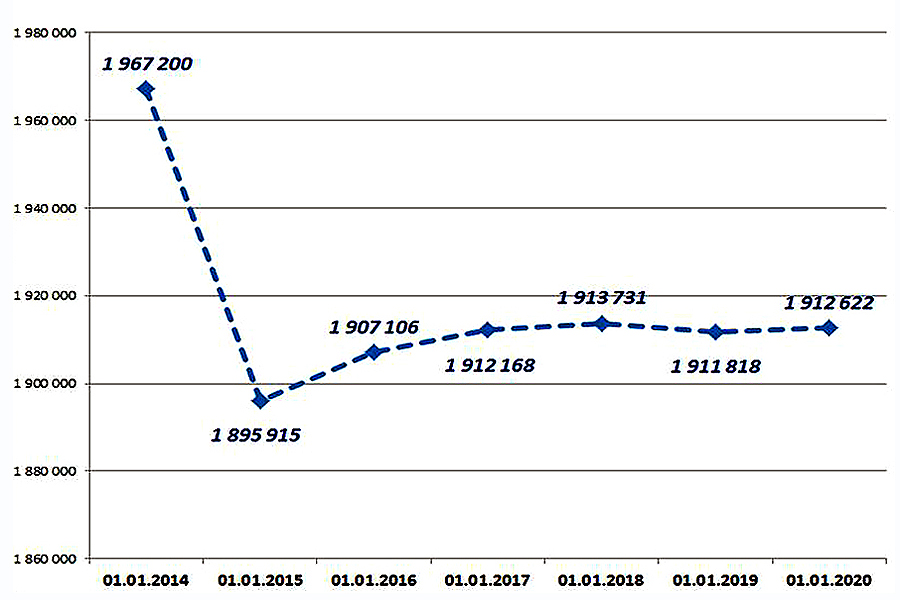
during the occupation period as at 1 January 2020, persons. Chart 1
The size of the resident population
of Sevastopol in 2014-2019
During the years of the occupation, the size of the resident population of occupied Sevastopol has shown fundamentally different trends from occupied Crimea.
|
The resident population of Sevastopol in 2014-2019, persons. Table 2 |
||
|
Date |
Number of people |
Source |
|
01.01.2014 |
383 304 |
State Statistics Service of Ukraine |
|
14.10.2014 |
393 304 |
Russian census |
|
01.01.2015 |
398 973 |
Russian Federal State Statistics Service (Rosstat) |
|
01.01.2016 |
416 263 |
Rosstat |
|
01.01.2017 |
428 753 |
Rosstat |
|
01.01.2018 |
436 670 |
Rosstat |
|
01.01.2019 |
443 212 |
Rosstat |
|
01.01.2020 |
449 138 |
Rosstat |
According to the latest pre-war Ukrainian statistics, as at 1 January 2014, i.e. two months before the occupation, the resident population of Sevastopol was 383,304 people. The Russian census conducted eight months after the beginning of the occupation showed an increase in population by 10 thousand people. And then an unprecedentedly rapid growth due to migration began, which has continued to the present day (see Chart 2).
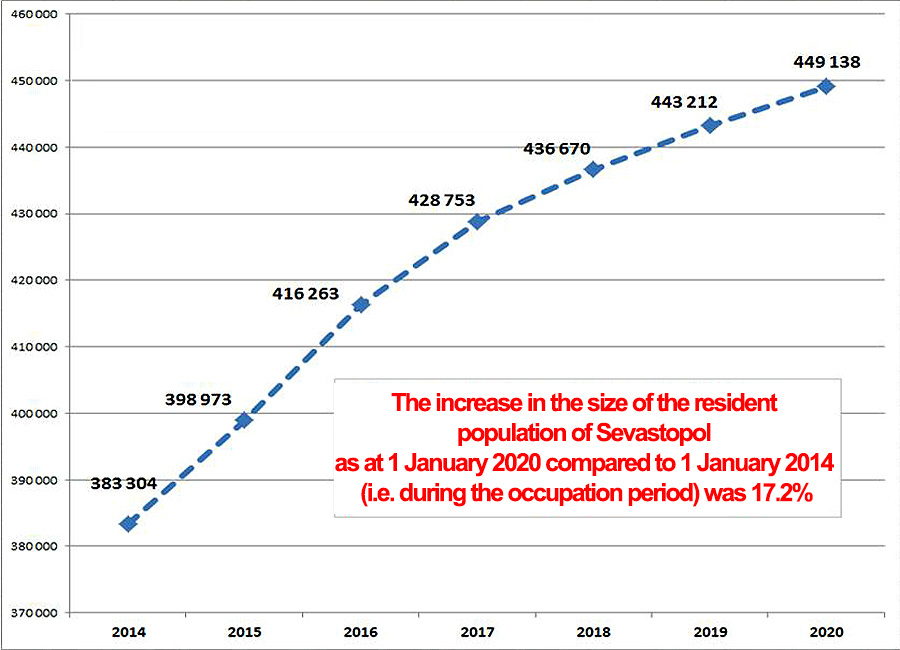
Overall, during the years of the occupation, the absolute size of the resident population of Sevastopol has increased from 383,304 to 449,138 people, i.e. by 65,834 people, or by an unprecedented 17.2%.
The resident population of Sevastopol
and external migration in 2014-2019
Reference: Until 5 April 2016, the Federal Migration Service (FMS) of Russia, the federal executive body, was responsible for permanent residence registration and migration issues. On 5 April 2016, this agency was dissolved by a decree of the President of the RF, and its functions and powers were returned to the Main Directorate for Migration of the Ministry of Internal Affairs of the Russian Federation.
|
External migration to Sevastopol over the years of the occupation. Table 3 |
|||
|
Year |
Total number |
From Russia |
From "the CIS states" |
|
2014 |
14 182 |
11 380 |
2 802 |
|
2015 |
24 766 |
16 889 |
7 877 |
|
2016 |
18 759 |
13 417 |
5 342 |
|
2017 |
16 091 |
12 439 |
3 652 |
|
2018 |
16 413 |
12 827 |
3 586 |
|
2019 |
16 858 |
12 036 |
4 822 |
|
|
107 069 (100%) |
78 988 (73,77%) |
28 081 (26,23%) |
Thus, during the years of the occupation of the Crimean peninsula (as at 1 January 2020) 107,069 people have moved to Sevastopol:
- 73.77% of them, or 78,988 people, had previously resided permanently in the regions of the Russian Federation;
- 26.23% of them, or 28,081 people, had lived permanently in the Donetsk and Luhansk regions of Ukraine.
In order to adequately assess the scale of the phenomenon, note that the number of external migrants has already amounted to 27.93% of the size of the resident population of Sevastopol before the occupation. That is, the migration gain has compensated for all the negative demographic processes in the city and provided an enormous increase in the size of the resident population.
It is worth mentioning that the migration gain as a result of the migration from the regions of the Russian Federation to Sevastopol has been constant and steady at the level of 12,000-13,000 people a year. This is the direct evidence of the systematic increase in the Russian military contingent in the main base of the Russian Black Sea Fleet. This main migration flow to Sevastopol consists of the Russian military and members of their families.
The prime motive for their official permanent residence registration in Sevastopol is the opportunity to take out preferential military mortgages to buy their own dwellings.
Another component of the migration flow that has been increasing the size of the resident population of Sevastopol is Russian retired people from remote areas of northern Russia and Siberia.
As to migrants from the Donbas, who are shown in Russian official statistics as "migrants from the CIS countries", the real situation is different. The bulk of the migrants from the Donetsk and Luhansk regions moved to the Crimean peninsula immediately after the beginning of hostilities in the Donbas caused by Russian aggression.
As early as the end of November 2014, the FMS of the Russian Federation spread the message that there were approximately 200,000 people in Crimea who had left the Donbas as a result of hostilities.
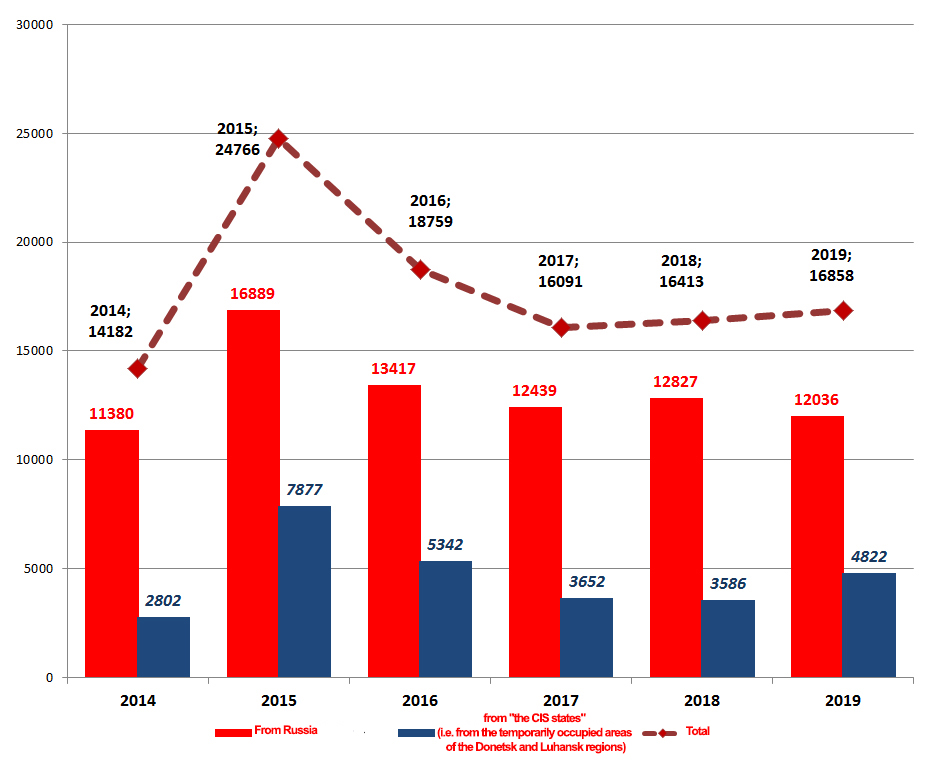
Trends in the number of people who moved to Sevastopol during the occupation period
as at 1 January 2020, persons. Chart 3
Note that before the occupation, there were a lot of recreational housing construction projects in Crimea. Those second homes by the sea were in great demand among people in eastern Ukraine. Therefore, many residents of the Donbas escaped the war by moving to their Crimean flats.
In addition, since the early days of the war in the Donbas, there has been close cooperation between the occupying authorities of Crimea and the puppet regimes of the so-called "people's republics" in the Donbas.
This was manifested both in the training of militant units in Crimea and the treatment of the wounded, which have also become a factor in the "Donetsk migration" to occupied Crimea.
Therefore, Chart 3 on Sevastopol and Chart 4 on the Autonomous Republic of Crimea show not the annual trends in migration from the Donbas to Crimea, which has long been absent, but the trends in the process of obtaining Russian passports and permanent residence registration in Sevastopol and Crimea by the Donbas residents who arrived in Crimea in 2014.
The resident population of occupied Crimea
(excluding Sevastopol)
and external migration in 2014-2019
According to the official statistics of the occupying authorities, during the years of the occupation of Crimea as at 1 January 2020, 159,389 people have moved to Crimea (excluding Sevastopol).
- 60.45% of them, or 96,351 people, had previously resided permanently in the Russian Federation;
- 39.55% of them, or 63,038 people, had lived permanently in the Donetsk and Luhansk regions of Ukraine.
In order to assess the scale of the phenomenon, note that the number of external migrants has amounted to 8.1% of the size of the resident population of Crimea before the occupation.
That is, in contrast to Sevastopol, where that figure reached 27.93%, the migration gain in occupied Crimea has only compensated for the natural population decline but has not increased the size of the resident population.
It is worth noting that the migration gain of the resident population (let's emphasize the word resident) from the regions of the Russian Federation to occupied Crimea has been growing steadily during the years of the occupation.
|
External migration to Crimea (excluding Sevastopol) over the years of the occupation. Table 4 |
|||
|
Year |
Total number of people |
From Russia |
From "the CIS states" |
|
2014 |
18109 |
8943 |
9166 |
|
2015 |
31518 |
14644 |
16874 |
|
2016 |
26304 |
16386 |
9918 |
|
2017 |
26352 |
17061 |
9291 |
|
2018 |
27292 |
19147 |
8145 |
|
2019 |
29814 |
20170 |
9644 |
|
|
159389 |
96351 (60,45%) |
63038 (39,55% ) |
However, the nature of this growth is more complex than in Sevastopol:
- firstly, similarly to Sevastopol, it is the flow of migrants from the Russian military and members of their families, who have settled mainly in Yevpatoria, Feodosia, and Kerch;
- secondly, similarly to Sevastopol, these are also Russian retired people from remote areas of northern Russia and Siberia, who buy apartments mainly in Simferopol or Yalta and other coastal cities;
- thirdly, these are representatives of the Russian middle class, who change their permanent place of residence mainly for reasons of environmental and climatic conditions;
- fourthly, it is part of Russian officials, mostly security officials, and members of their families, for whom having Schengen visas is not essential (which is not possible with permanent residence registration in occupied Crimea).
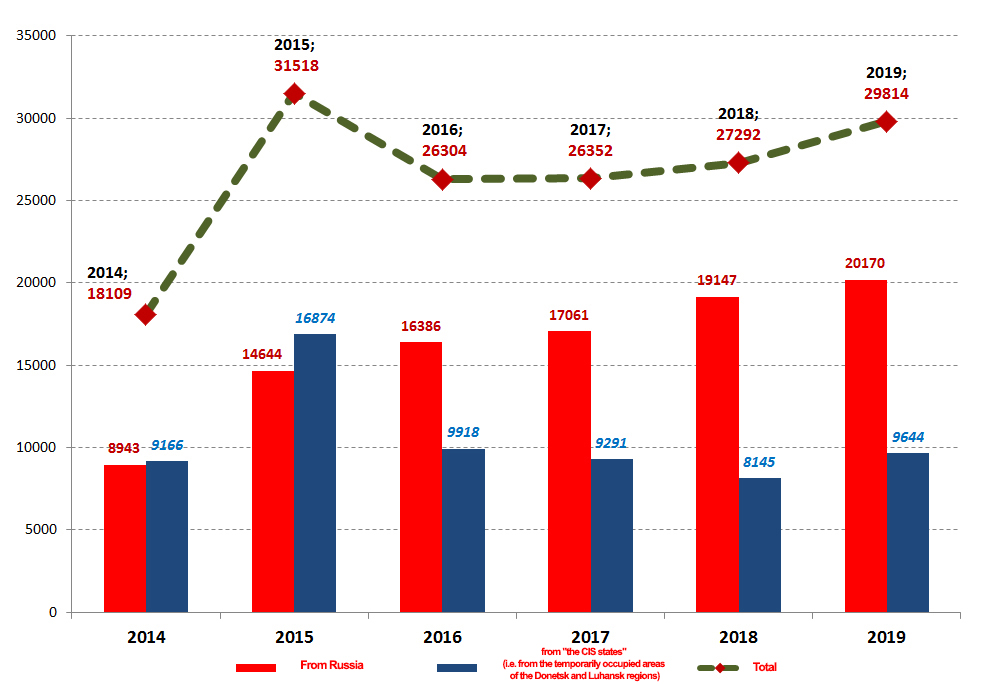
Trends in the number of people who moved to Crimea (excluding Sevastopol) during the occupation period as at 1 January 2020, persons. Chart 4
Characteristics and the ratio of the number of people
who moved to Crimea to the number of people
who left Crimea in 2015-2019
Let us pay attention to another important aspect of the problem: while in Sevastopol we mainly observe just an increase in the size of the population due to external migration, in Crimea, the replacement of the population is taking place, i.e. the replacement of those who leave the peninsula by those who move to Crimea.
From the analysis of the data presented in Chart 5, it is clear that during all the years of the occupation, there has been a very significant number of people leaving Crimea, which is comparable to the number of those moving to Crimea. The basis of this flow is Crimeans moving to the Russian Federation.
This flow has been relatively steady, ranging from 15,000 to 17,000 people a year.
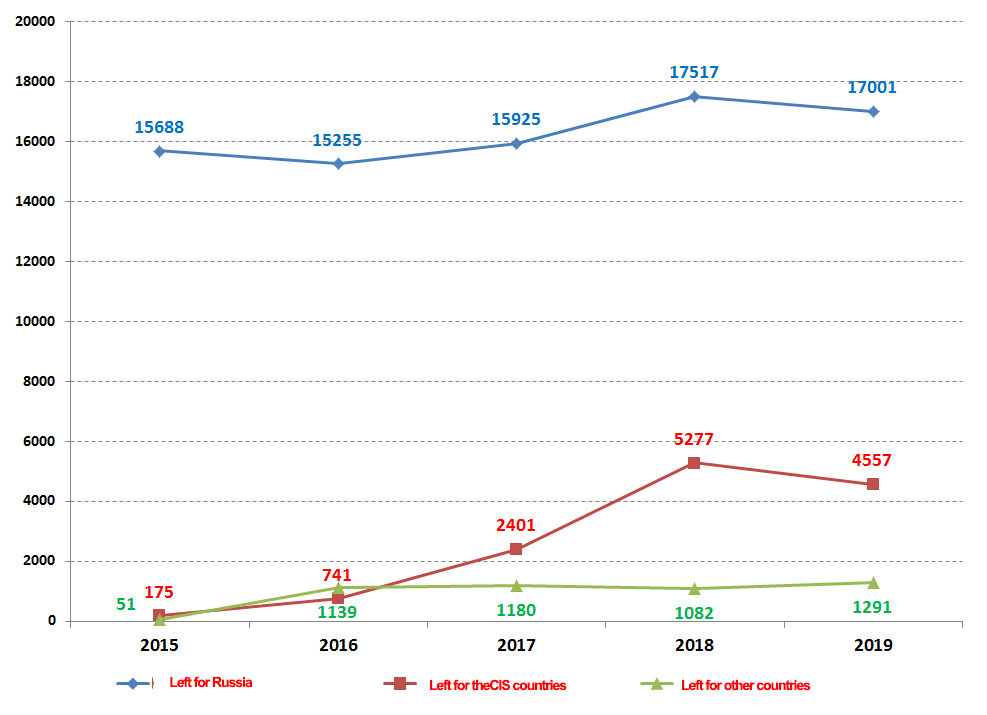
Trends in the number of people who left Crimea (excluding Sevastopol) during the occupation period
as at 1 January 2020, persons. Chart 5
It is mainly composed of young people who leave Crimea to go to higher educational institutions. The reason for that is international sanctions for the occupation and attempted illegal annexation of Crimea.
One of the effective components of the sanctions regime is the non-recognition of any documents issued by the Russian Federation on the occupied peninsula, including diplomas of education. Those are recognized only in Russia, but even in Russia, companies involved in international projects have long avoided hiring professionals with Crimean diplomas.
Since 2017, the flow of Crimean residents leaving for mainland Ukraine has resumed (this figure is "disguised" in the occupiers’ statistics as "leaving for the CIS countries"). The size of this migration flow is about 5,000 people a year.
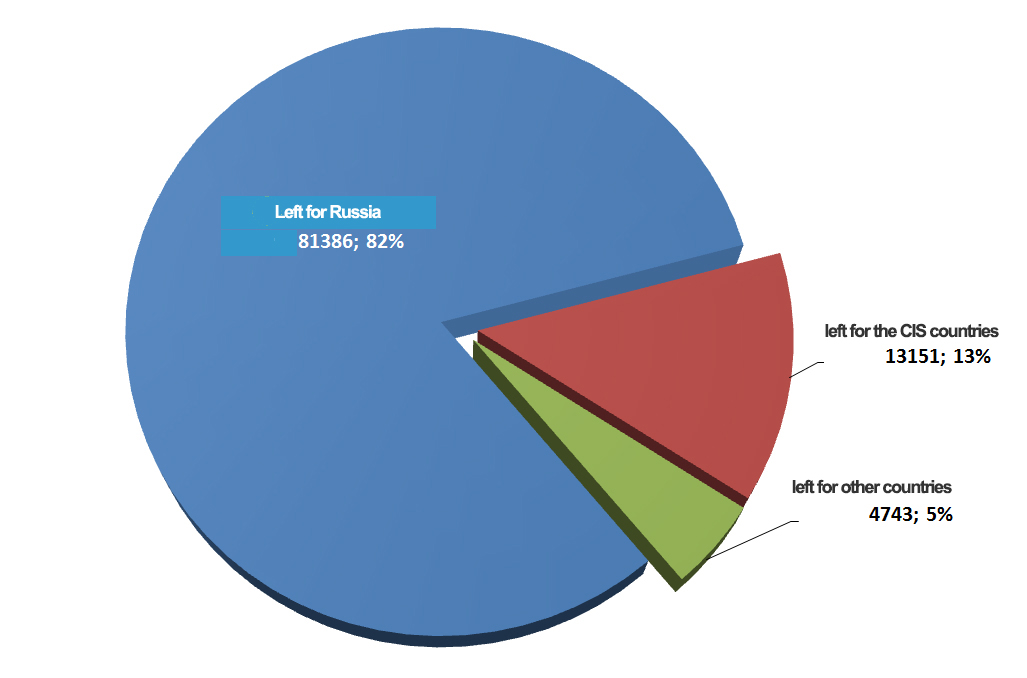
The structure of the migration flow from Crimea (excluding Sevastopol) during the occupation period
as at 1 January 2020, persons. Chart 6
In 2014, the first year of the occupation, reliable migration statistics on the number of people leaving Crimea were not produced. The comparison of migration flows to and from Crimea (excluding Sevastopol) during the period of the occupation from 2015 to 2019 (see Chart 7) clearly illustrates how the replacement of the population has been carried out.
Instead of 99,280 Crimeans who left the peninsula in 2015-2019, 148,178 new "colonizers" moved to Crimea, i.e. there were 1.5 times more people who moved to Crimea than those who left it.
In addition, about 70,000 Crimean residents who left the peninsula for political reasons in the first year of the occupation and became "internally displaced persons" should be added to this migration balance.
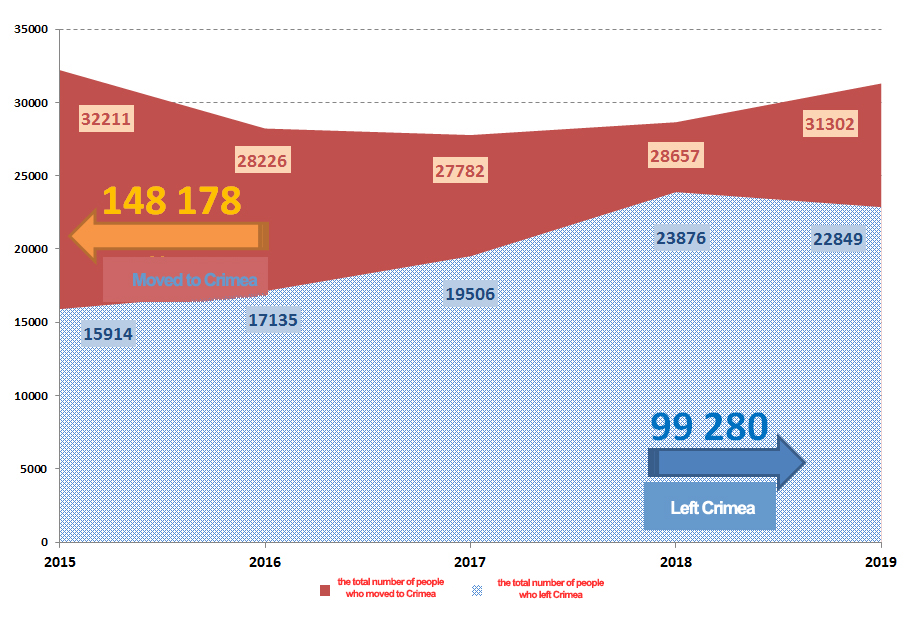
The comparison of migration flows to and from Crimea (excluding Sevastopol) during the period of the occupation as at 1 January 2020, persons. Chart 7
To draw conclusions and make generalizations, it is necessary to estimate another demographic indicator, the de facto population of the peninsula.
The estimate of the de facto population
of occupied Crimea and Sevastopol
Russian statistics agencies, as a rule, publish information on the resident population, i.e. the part of the population that has officially registered the place of residence in Sevastopol and Crimea in the local migration agencies of the Russian Ministry of Internal Affairs, regardless of the actual location.
There is another important indicator for this study - the de facto population, i.e. the total of all persons living in a geographical area, regardless of their place of residence. Under the legislation of the Russian Federation, temporarily present people have to register at the place of temporary residence if they arrive in a locality for longer than 90 days.
There is no official information in the open sources about the temporarily present population that has registered its long stay on the territory of the Crimean peninsula.
Meanwhile, estimates expressed by residents on social media sites, journalists, real estate and housing experts, officials of the occupation administrations, show, for example, that the de facto population of Sevastopol is 700 thousand people, while its resident population is 450 thousand people.
On 28 April 2020, Russian media reported that Acting Russian Governor of occupied Sevastopol Mikhail Razvozhayev told Russian President Putin at a meeting on combating the coronavirus:
"According to statistics, it was necessary to have hospital bed capacity at the rate of 450 thousand people, I immediately decided to have twice as many, since it is obvious from the consumption of water and bread that more than 700 thousand people live in Sevastopol. "
Similarly, experts estimate the size of the de facto population of Simferopol to be about 600 thousand people, while its resident population is 362 thousand people.
It is not difficult to solve the riddle if we remember the word "sanctions".
Having a stamp of permanent residence registration in occupied Crimea in a Russian internal passport makes it impossible for its holder to obtain visas to the EU, the USA, the UK, and other states that do not recognize the occupation and attempted annexation of Crimea, as well as to have access to other services, such as banking, in the civilized world.
Therefore, it is not surprising that tens of thousands of Russian citizens who live and work in occupied Crimea are in no hurry to change their Moscow or Saratov permanent residence registration to the Crimean one.
First of all, we are talking about thousands and thousands of employees of occupation executive branch agencies and members of their families:
- about 30 local agencies of federal law enforcement, judicial, and military agencies (the Ministry of Internal Affairs, the FSB, the Investigative Committee, the Customs Service, prosecutor's offices, the Border Service, etc.);
- about 40 local agencies of the federal government agencies of the Russian Federation (the Tax Service, the Treasury, the Pension Fund, various types of supervision, etc.);
35 executive agencies of Crimean subordination: 19 ministries, 8 state committees, 8 services and inspectorates. They have 445 subordinate enterprises and organizations, including factories, agricultural enterprises, health retreats, nature reserves, etc.
Since the first days and during all the years of the occupation, Russia has been methodically creating its repressive and administrative apparatus in Crimea and Sevastopol by relocating there personnel from Moscow and other regions: law enforcement agencies, supervisory agencies, "supervisors" in the republican and municipal agencies of the occupied territory.
According to estimates based on the analysis of both public and insider information, the proportion of officials relocated from Russia in the departments of Russian federal agencies in Crimea reporting directly to Moscow reaches 70%, in the departments reporting to Simferopol – 50%. These figures are constantly increasing.
Crimean leaders of the collaborationist "Crimean government", government and municipal officials are gradually and systematically being replaced by officials from various regions of Russia, often from depressed regions of the European part of Russia, including the northern ones, and from remote Siberian cities.
Since 2016, the replacement of local personnel by that from Russia has been taking place in areas such as education and health care, due to relocation to Crimea of family members of Russian officials and the military, as well as builders of the Crimean bridge and the Tavrida motorway, military plants engineers.
In 2019, another stage of the staff replacement began: the former head of the Bilorichensky district of Krasnodar Krai of the Russian Federation was appointed head of the occupation administration of the resort capital of the peninsula, the city of Yalta. Understanding the general logic of the processes, we can expect that this was the beginning of the stage of replacing the leadership of the Crimean cities and districts with Russian personnel.
However, back to the migration balance
Summarizing the statistics, calculations, and estimates outlined above, we can conclude that during the years of the occupation, the population of the peninsula including Sevastopol has increased by at least 800 thousand – 1 million people due to external migration. This estimate is comprised of the following components:
- As at 1 January 2020, 107,069 people moved to Sevastopol;
- As at 1 January 2020, 159,389 people moved to occupied Crimea;
- the de facto population of Sevastopol and Simferopol is estimated to be at least 300 thousand people larger in each city than the resident population;
- the de facto population of Yalta, Alushta, Yevpatoria, Feodosia is estimated to be at least 10-20 thousand people larger in each city than the resident population.
Thus, as at 1 January 2020, the estimate of the de facto population of the occupied Crimean peninsula is as follows.
- As at 1 January 2020, the resident population of Crimea excluding Sevastopol = 1,912,622 persons.
- As at 1 January 2020, the resident population of Sevastopol = 449,138 persons.
- The total resident population = 1,912,622 + 449,138 = 2,361,760 persons.
- The minimum estimated size of the unregistered temporary population = 300,000 (Sevastopol) + 300,000 (Simferopol) + 50,000 (other cities) = 650,000 persons.
- As at 1 January 2020, the minimum estimated size of the de facto population of the Crimean peninsula = 3,011,760 people.
Thus, the de facto population of the Crimean peninsula is at least 3 million people compared with 2,35 million people before the occupation.
Of course, the international sanctions regime and the lack of the Dnieper water supply to the peninsula through the North Crimean Canal act as an effective deterrent – without those, the number of Russian colonizers on the occupied peninsula would be much larger.
* * *

This article has been published with the support of ZMINA
Human Rights Centre.
The content of the article is the sole responsibility of the authors
More on the topic
- 21.08.2023 Peculiarities of the 2023 Crimean Holiday Season — a «Tourism» in Camouflage
- 06.08.2023 Crimea During the Great War. Part 2. Extreme Tourism or «New Types of Tourism» and Tourist Numbers (2)
- 21.07.2023 Crimean Titan: Under a Russian Holding or a Ukrainian Tank?
- 12.06.2023 Crimea during the Great War. The situation in the occupied Crimea in 2022-2023. Military Context (1)
- 23.11.2021 Occupied Crimea. Exports and Imports / 2014-2021
- 23.11.2021 Water in Occupied Crimea / 2014-2021
- 23.11.2021 The Crimean Budget. Small Business. Salaries and Pensions / 2014-2021
- 23.11.2021 The "Trophy Economy". The Commercial Exploitation of Marine Biological Resources in the Black Sea and the Sea of Azov / 2014–2021
- 21.11.2021 The "Trophy Economy". Militarization as a Factor of Industrial Growth / 2014-2021
- 21.11.2021 Back in the USSR. The Reverse Restructuring of the Crimean Economy / 2014-2021
- 20.11.2021 The "Trophy Economy". The Development of the Stolen Ukrainian Black Sea Shelf / 2014-2021
- 20.11.2021 The Occupied Crimean Tourism / 2014-2021